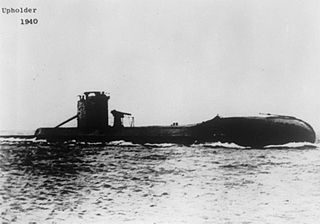
HMS Upholder (P37) was a Royal Navy U-class submarine built by Vickers-Armstrong at Barrow-in-Furness. She was laid down on 30 October 1939, launched on 8 July 1940 by Mrs. Doris Thompson, wife of a director of the builders. The submarine was commissioned on 31 October 1940. She was one of four U-class submarines which had two external torpedo tubes at the bows in addition to the 4 internal ones fitted to all boats. They were excluded from the others because they interfered with depth-keeping at periscope depth.

German submarine U-51 was a Type VIIB U-boat of Nazi Germany's Kriegsmarine that operated during World War II. She was ordered on 21 November 1936 and laid down on 26 February 1937 in Kiel. She was launched on 11 June 1938 and commissioned on 6 August 1938.
German submarine U-30 was a Type VIIA U-boat of Nazi Germany's Kriegsmarine that served during World War II. She was ordered in April 1935 in violation of the Treaty of Versailles, which prevented the construction and commissioning of any U-boats for the German navy, and as part of the German naval rearmament program known as Plan Z. She sank the liner SS Athenia (1922) on 3 September 1939, under the command of Fritz-Julius Lemp. She was retired from front-line service in September 1940 after undertaking eight war patrols, having sunk 17 vessels and damaging two others. U-30 then served in a training role until the end of the war when she was scuttled. She was later raised and broken up for scrap in 1948.

The French submarine Rubis was a Saphir-class minelaying submarine which first served in the French submarine pavilion, then the Free French Naval Forces (FNFL) during the Second World War and back with the French Navy. The boat was awarded numerous awards. Accordingly, as a result of Rubis's service with the FNFL, the boat was made a companion of the Ordre de la Libération by a decree issued by General Charles de Gaulle on 14 October 1941.
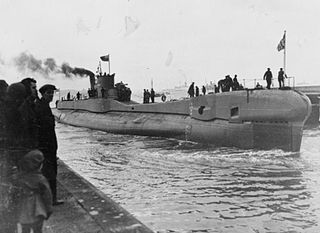
HMS Trident was a British T class submarine built by Cammell Laird, Birkenhead. She was laid down on 12 January 1937 and was commissioned on 1 October 1939. HMS Trident was part of the first group of T class submarines.
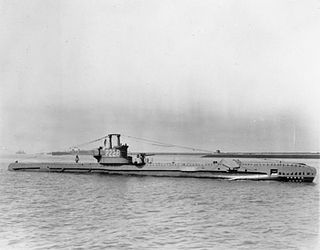
HMS Splendid was a third-batch S-class submarine built for the Royal Navy during World War II. She was laid down on 7 March 1941 and launched on 19 January 1942. After an initial patrol through the Bay of Biscay to Gibraltar, Splendid conducted two patrols in the Mediterranean Sea; one was abandoned after technical problems and on the other she sank two Italian ships. On her next patrol, the submarine attacked two Italian convoys, sinking an Italian destroyer in the second attack. Based in Algiers, the boat operated north of Sicily, sinking six Italian ships, including two tankers and two heavy merchant ships. Splendid was detected by a German destroyer on 21 April 1943 while patrolling off Naples, Italy; the submarine was attacked with depth charges by the destroyer and forced to surface, after which she was scuttled and her surviving crew members taken prisoner. She was the most successful British submarine by tonnage sunk between November 1942 and May 1943.
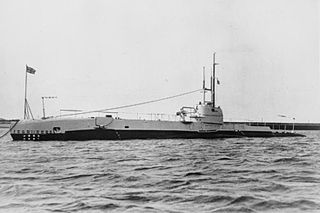
HMS Snapper was a second-batch S-class submarine built during the 1930s for the Royal Navy. Completed in 1935, the boat participated in the Second World War. Snapper is one of the 12 boats named in the song "Twelve Little S-Boats".
HMS Porpoise (N14) was one of the six-ship class of Grampus-class mine-laying submarines of the Royal Navy. She was built at Vickers Armstrong, Barrow and launched 30 August 1932. She served in World War II in most of the naval theatres of the war, in home waters, the Mediterranean and the Far East. She was sunk with all hands by Japanese aircraft on 19 January 1945, and was the last Royal Navy submarine to be lost to enemy action.
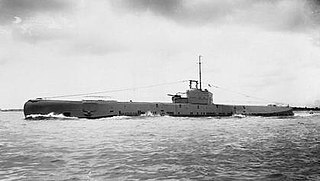
HMS Cachalot (N83) was one of the six-ship class of Grampus-class mine-laying submarine of the Royal Navy. She was built at Scotts, Greenock and launched 2 December 1937. She served in World War II in home waters and the Mediterranean. She was rammed and sunk by the Italian torpedo boat Generale Achille Papa on 30 July 1941.

HMS Rorqual (N74) was a British mine-laying submarine, one of the six ships of the Grampus class of the Royal Navy. She was built by Vickers Armstrong, Barrow and launched 27 July 1936. She served in the Second World War in the Mediterranean and in the far east. She was the only Grampus-class submarine to survive the war, and she is considered the most successful minelaying submarine of World War II, sinking 57,704 GRT of enemy shipping, 35,951 of which through her mines.

HMS Utmost was a British U class submarine, of the second group of that class, built by Vickers Armstrong, Barrow-in-Furness. She was laid down on 2 November 1939 and was commissioned on 17 August 1940. So far she has been the only ship of the Royal Navy to bear the name Utmost.
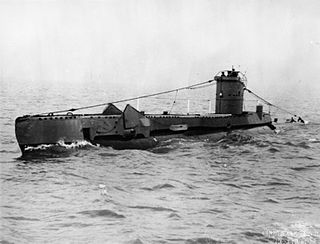
HMS Untiring (P59) was a Royal Navy U-class submarine built by Vickers-Armstrong. So far she has been the only ship of the Royal Navy to bear the name Untiring. After the war, she was loaned to the Greek Navy and renamed Xifias (Y-10).

Naval trawlers are vessels built along the lines of a fishing trawler but fitted out for naval purposes; they were widely used during the First and Second World Wars. Some—known in the Royal Navy as "Admiralty trawlers"— were purpose-built to naval specifications, others adapted from civilian use. Fishing trawlers were particularly suited for many naval requirements because they were robust vessels designed to work heavy trawls in all types of weather, and had large clear working decks. A minesweeper could be created by replacing the trawl with a mine sweep. Adding depth charge racks on the deck, ASDIC sonar below, and a 3-inch (76 mm) or 4-inch (102 mm) gun in the bow equipped the trawler for anti-submarine duties.
SM UC-63 was a German Type UC II minelaying submarine or U-boat in the German Imperial Navy during World War I. The U-boat was ordered on 12 January 1916, laid down on 3 April 1916, and was launched on 6 January 1917. She was commissioned into the German Imperial Navy on 30 January 1917 as SM UC-63. In nine patrols UC-63 was credited with sinking 36 ships, either by torpedo or by mines laid. UC-63 was torpedoed and sunk by HMS E52 off Goodwin Sands on 1 November 1917; only one crewman survived the sinking.
The Torpedo Alley, or Torpedo Junction, off North Carolina, is one of the graveyards of the Atlantic Ocean, named for the high number of attacks on Allied shipping by German U-boats in World War II. Almost 400 ships were sunk, mostly during the Second Happy Time in 1942, and over 5,000 people were killed, many of whom were civilians and merchant sailors. Torpedo Alley encompassed the area surrounding the Outer Banks, including Cape Lookout and Cape Hatteras.

HMS Whitehall, pennant number D94, later I94, was a Modified W-class destroyer of the British Royal Navy that saw service in the Second World War.

The Barents Sea campaign in 1941 was a submarine operation in the Arctic waters of the Barents Sea during World War II. It was a combined Soviet and British campaign, with boats departing from Polyarny to harass German shipping along the Norwegian coast.
M 1507 Teutonia was a German fishing trawler that was requisitioned by the Kriegsmarine in the Second World War for use as an auxiliary minesweeper. Built as Teutonia, she served as M 1507 Teutonia, the vorpostenbootV 204 Teutonia and M 4628 Teutonia. She became the French fishing trawler Rouget post-war and was scrapped in 1961.













